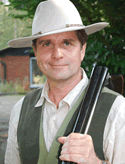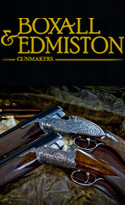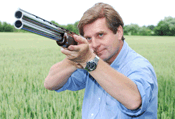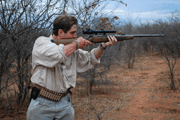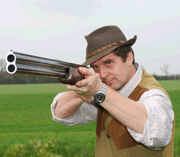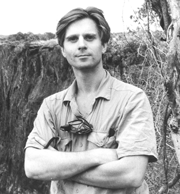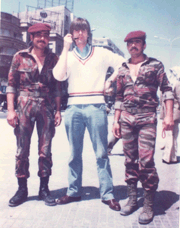Mount and Swing
A good gun mount - the way the hands bring the gun to face and shoulder - is the hall mark of a good shotgunner. Even in pre-mounted disciplines like ATA trap, the initial mount is critically important. It should always be an unhurried but positive action, executed to three beats at a relatively slow tempo. Many, if not most, poor shots rush the mount, losing control of the muzzles in the process. The frequent tendency when shooting from a gun down position is to 'bash and slash', i.e. to slam the gun up to the shoulder at lightning speed and then slash at the target. Wild shooting is the result. It might be noted, moreover, that those inclined to rush, often end up rushing to a dead stop (and so miss the bird behind with a puzzled look on their face).
The essential problem of the mount and swing - it is hard to consider one without the other - is that one must achieve control without checking gun movement unduly. There needs to be economy of movement but flow as well. The gun stock is raised to face and shoulder with a co-ordinated movement of both hands; if any hand leads this action, it is the leading one. It fulfils a critical function keeping the muzzles on line as mount and swing progress, it helps to push the gun ahead of the target (though the primary energy for this is body rotation) and it has a vital role in finishing the shot. I often note that the left arm of clients does insufficient work and the right arm and hand too much. The required balance of action is not achieved and the gun 'cartwheels'.
Unnecessary head movement is also detrimental to a good mount (to find out why try pointing at a distant object whilst keeping your head still, then try the same thing whilst lifting the head). The head should remain almost still relative to the neck and shoulders as the mount and swing progress. As the stock comes to the face it locates comfortably under the cheek-bone. The head is not forced down onto the stock, but the cheek is in positive contact with the wood. Many shots fire their guns with their heads off the stocks. Although one can get away with it on some driven targets, it can all too easily result in apparently inexplicable misses behind and above.
Advice on the starting position for muzzles and butt varies. Let us try to keep it simple. I would consider it a mistake to hold the muzzles above the line of any crossing clay bird. The British instructor Percy Stanbury, advised keeping the muzzles well up - touching the line of sight - and butt fairly low. Robert Churchill, advocated an unusual starting position with the butt tucked in under the armpit and the muzzles low - parallel to the line of sight. This has also been adopted by the Holland and Holland Shooting School. In the case of the first mentioned style, the gun should pivot about the axis of the muzzles as the mount progresses. It should also be pushed towards the target with the shoulder going forward to meet it as the mount is completed. In the case of the Churchill mount there is an exaggerated pushing out of the gun as the mount commences and a less obvious movement of the shoulder to the gun at the end (although Churchill would have argued the point).
Experiment has lead me to a 'third way' where the muzzles are kept fairly high (just below the line of sight) and the heel of the stock is held in contact with the front of the armpit. This gets the best of both worlds. If I was to argue the merits of the classic approaches, I might note that the Stanbury technique is more generally useful and keeps the muzzles safely up when in the field. The Churchill method is excellent for anyone who is having problems with consistent gun mounting. It ensures that the gun is properly positioned at the shoulder and makes it easier to bring the gun to the face well. I often use the Churchill mount as a teaching aid before progressing to other things.
Where should the gun come to at the shoulder? It is often said that the sole of the butt must come to the 'shoulder pocket', that is the natural pocket between shoulder joint and collar bone. For many people, this is good advice, but some very good shots, mount their guns on or partially on the shoulder joint because they have a very narrow shoulder pocket. Frequently this works perfectly well. Mounting the gun on the arm, as will happen if the stock is too long, may be considered an absolute mistake. Elbow position is another variable. Some trap shots like to raise the elbow of the right/rear hand. This opens up the shoulder pocket and can work well with trap. I do not think that it is a good idea for sporting, skeet or field shooting because it can cramp the mount and swing. I generally prefer to see both elbows at about 45 degrees because I think that this is their most natural position when holding a gun and therefore the one likely to create the least tension and to encourage the smoothest swing.
In all cases, the gun mount should be an unhurried, fluid and rhythmic movement. A particular effort should be made to control the tip of the gun - the first few inches of the barrels - throughout the process. Many shotgunners (no matter that they are shooting sporting clays, gun-down skeet, or live birds) rush the mount. They bring the gun to the shoulder far too early in their swing. This leads to a 'mount and slash' style of shooting as noted earlier. Another common problem is 'cart-wheeling' where one allows the gun to pivot about the axis of the front hand with the muzzles moving messily below and above the line of sight to the target. A mount dominated by the rear hand nearly always leads to this sort of unnecessary and inelegant extra movement (the solution, of course, is for both hands to work together - but the means to this is for the front hand and arm to do more work). All keen shots should practice the mount as one might a golf swing. If you do this be careful to prove the gun empty first and do not just practice the simple forward mount at a static target, but perfect the combined swing and mount. Generate power for the swing from body rotation. Elevation and fine control comes from the front hand. Keep the shoulders level as you swing. Keep the head on stock as you follow through (I call this locking up). Finally, do not forget your rhythm: ONE: TWO: THREE.....YOU: WILL: WIN....THE BIRD:IS:SMOKE.
Tips for improving your mount
Practise a routine of mounting and swing every day
Bring the gun to your face - don't bring your face to the gun
When you practise dry mounting focus foward on a specific spot - don't look at the gun
Trying slow down your mount - what you think of as slow motion may well be an improvement
Build up the strength of your front arm - its role is critical but often forgotten
Make sure that you are a locked up unit - gun and upper body - when you fire
Follow through well - don't shortcut the swing.


